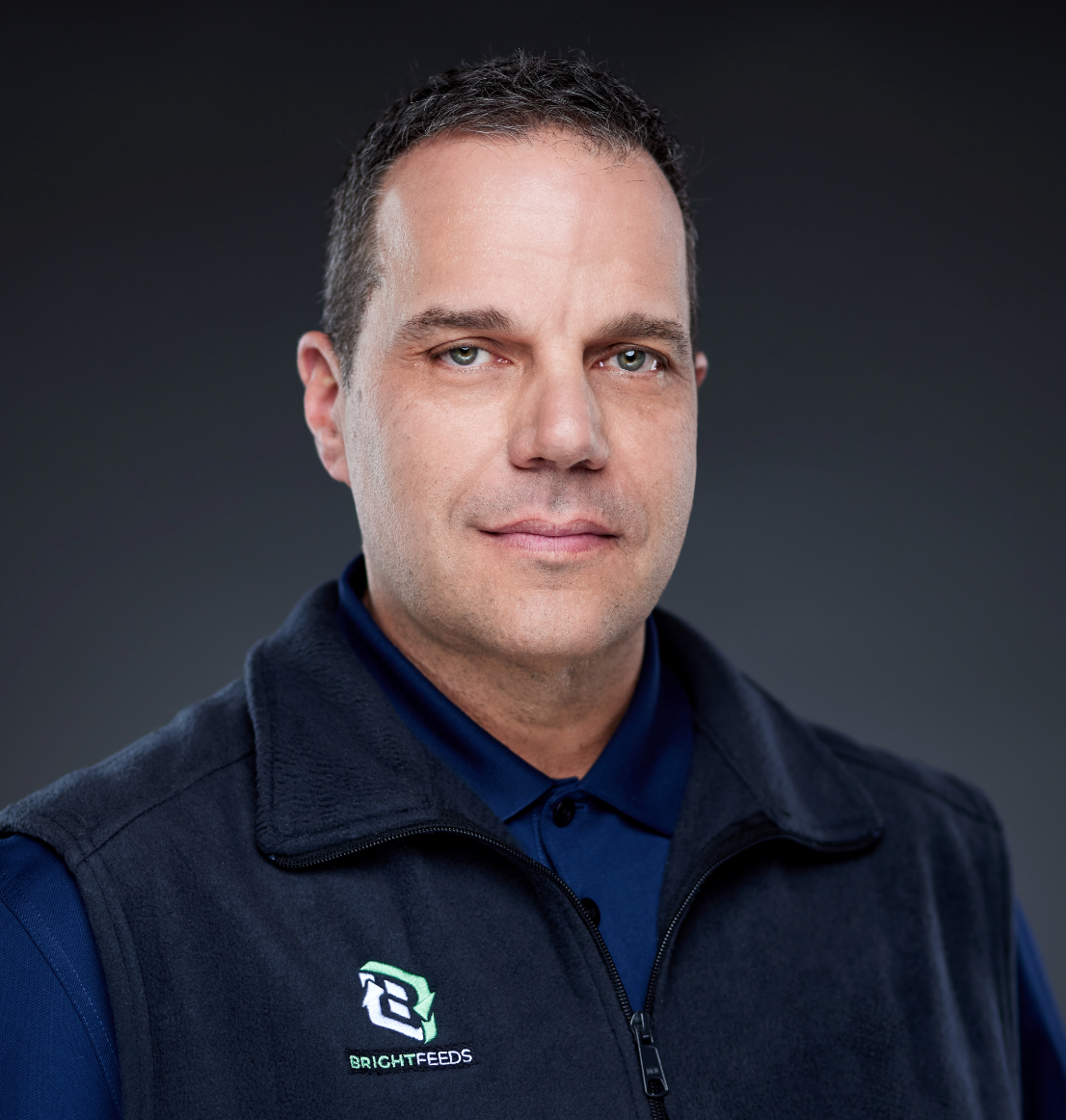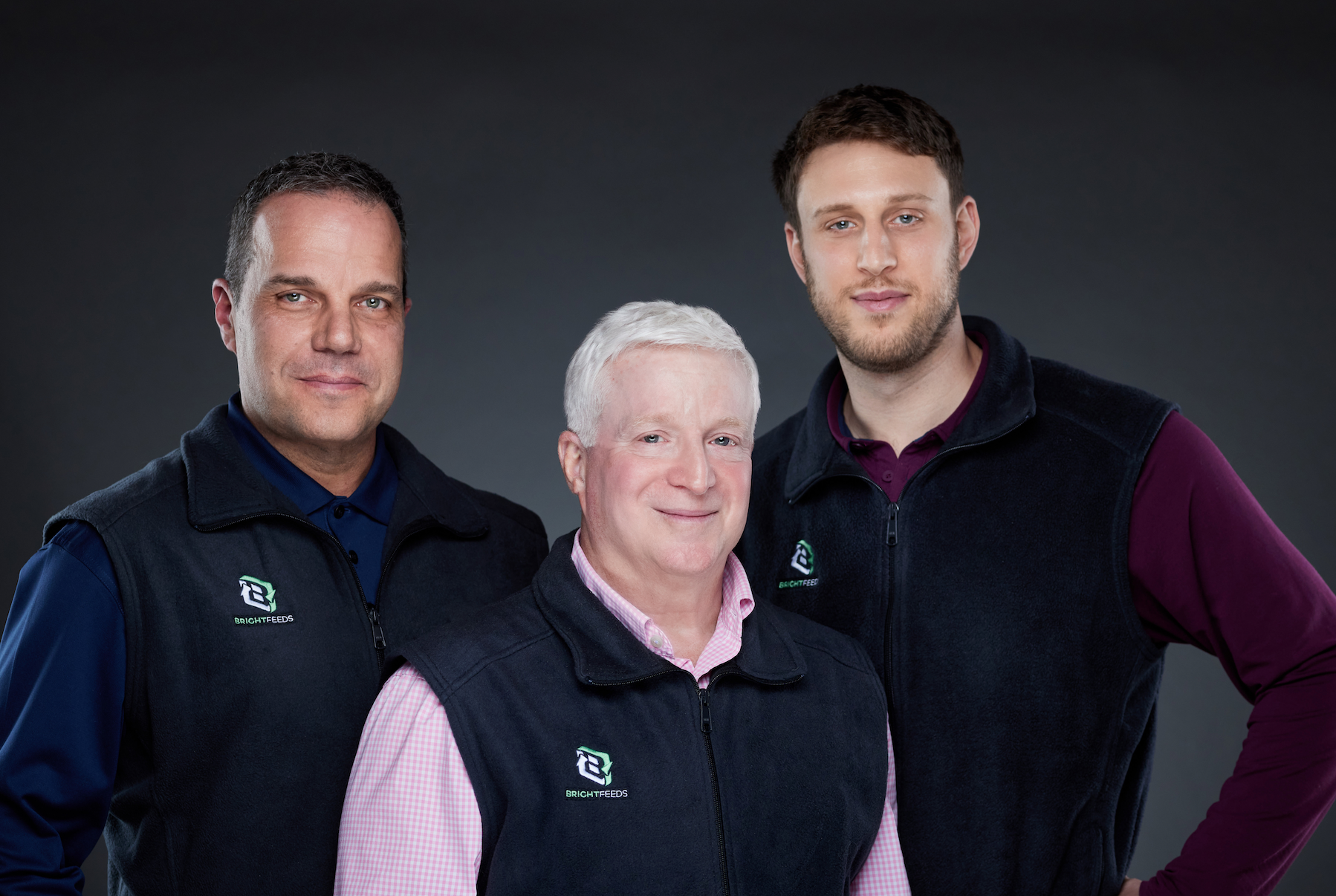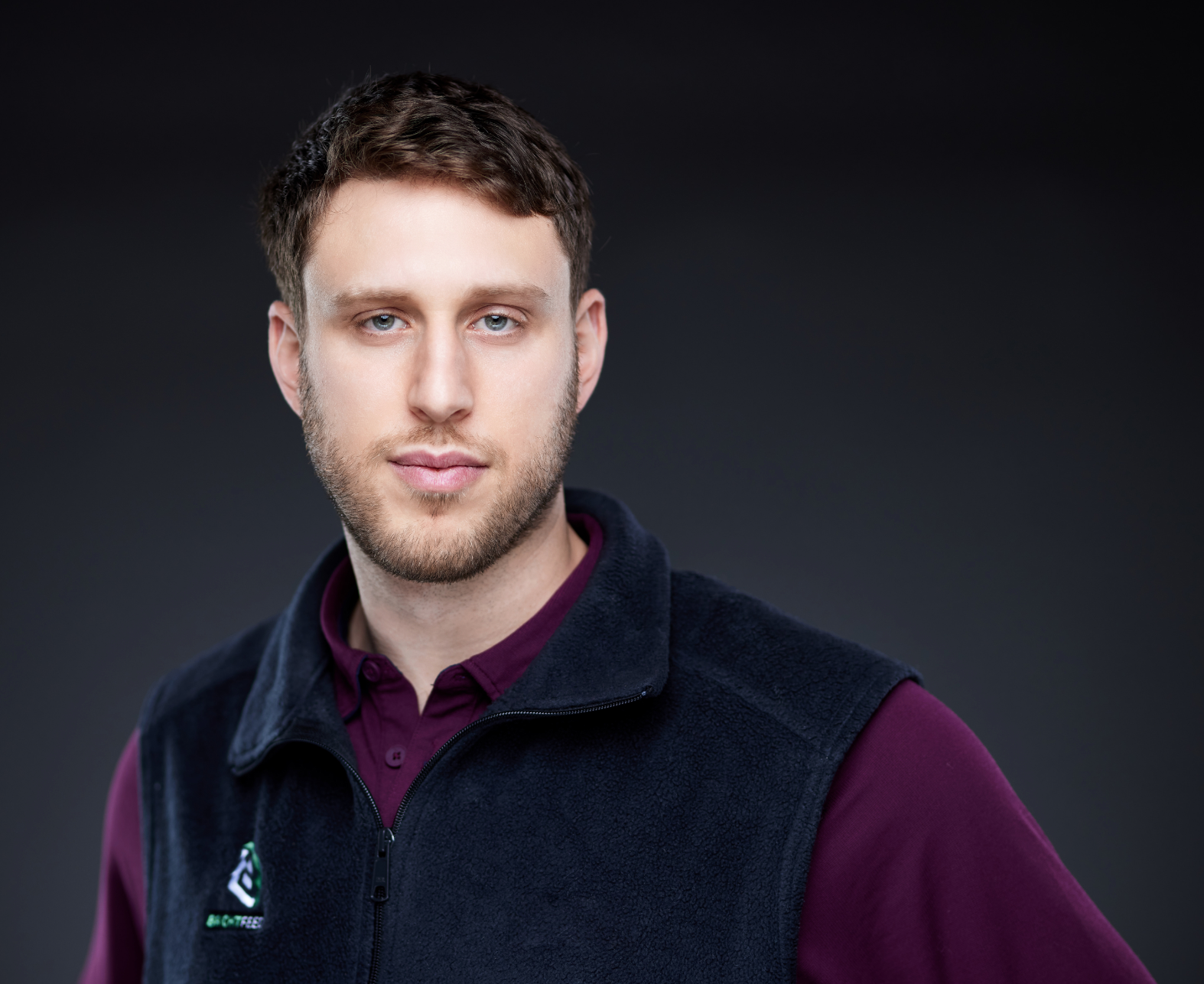
Waste Not Want Not. Meet Bright Feeds
The cutting-edge solution to food waste you need to know more about.
By Jeanine Behr Getz
Portraits by ChiChi Ubiña
It’s been 53 years since the first Earth Day, for many of us growing up in the early 70s, mealtime was infused with parental cajoling cliches like “waste not want not” and “eat everything on your plate, there are starving children in Africa.” Wasting food was egregious.
One vivid waste not want not childhood memory for me is one of waiting on my friends (family of 5 kids) to walk to school while they sat at their kitchen table, with weepy faces, watching them pinching their noses as they ate for breakfast what they didn’t finish from dinner the night before. Back then “money didn’t grow on trees” was also trending!
Today, seems like many of those old adages have gone by the wayside and wasted food in America is an epidemic. The USA wastes approximately 125-160 billion pounds of food each year. For clarification, food loss refers to food that unavoidably becomes unfit for human consumption before people have a chance to eat it. While food waste refers to discarded food that’s still fit for human consumption, either before or after it spoils. The causes of food loss and waste occur throughout the food supply chain, from farm or fishing boat, during production, processing, distribution, retail and food service sales, and at home.
Approximately 40% of the USA’s food is wasted every year. Not surprisingly, there are negative economic, environmental and social impacts of all this food waste. Wasted food is the single largest category of material taking up space in landfills, and our country is running out of landfill space. When we waste food, we also waste all the energy and water it took to grow, harvest, transport, and package it and then we waste more energy and spend many more dollars to manage and dispose of it. Wasting food is still egregious.
There are many contributing factors to our increased wasted food in America. Such as:
– Food packaging sizes have significantly increased
– Many Americans expect “perfect” produce
– Sell/Use by labels account for 7% of food waste
– Stores overstock to cater to customers
– Lack of food rescue and food reuse programs
Let’s take a deep breath, less talk, more action, stay with me, help is on the way!

Laxmi Wordham
Imagine my eco excitement when I learned about a CT grown business, who’s business model is economically viable, environmentally exceptional and commercially scalable. A trifecta born to profitably address one of the heaviest & costliest contributors to our country’s waste management crisis.
Environmental challenge meets economic solution – Bright Feeds. Meet the Bright Feeds super star executive team of CEO – Jonathan Fife, President & COO – Tim Rassias, CGO – Laxmi Wordham and Chairman of the Board, Greenwich local, Scott Kalb. Fairfield County LOOK sat down with them to learn more about their “bright” solution to tackling the heaviest low hanging fruit in our waste stream, food waste.
FCL: What is Bright Feeds?
BF: Bright Feeds is a Greentech startup that takes food waste and turns it into animal feed.
FCL: Why is the Bright Feeds solution at the top of the food waste diversion hierarchy?
BF: Food waste is an enormous global environmental issue. The Environmental Protection Agency (EPA) published a Food Recovery Hierarchy that lists the most sustainable food waste solutions from top to bottom. After prevention and feeding hungry people, the hierarchy lists feeding animals next, ahead of anerobic digestion, composting, incineration, and lastly landfills. EPA has determined that keeping food as food, whether for humans or animals, ranks higher than turning it into energy or fertilizer.

Tim Rassias
FCL: What inspired you all to start Bright Feeds?
BF: In 2020 it was announced that Connecticut’s Material Innovation and Recycling Authority (MIRA) would close its Hartford waste-to energy facility in 2022, which processed 720,000 tons of waste per year. The state’s Coalition for Sustainable Materials Management (CCSMM) asked for solutions to fill the gap. Bright Feeds emerged as a solution to the waste problem. Co-founders Jonathan Fife and Tim Rassias saw an opportunity to use innovative technology to solve the food waste issue and help companies and municipalities save money at the same time.
FCL: How does Bright Feeds solve the food waste issue?
BF: Bright Feeds’ transformative solution can process 160,000 tons of food waste per year thereby taking it out of the waste stream in a cost-effective manner and provides a more sustainable alternative to industrial uses, composting, landfills, and incineration. Its solution will play a critical role in addressing the waste problem in Connecticut while providing a model for the country on how to divert organic waste sustainably into a high value product.
FCL: What important skillsets do each of you bring to your BF team?
BF: We come from varied backgrounds that allow each of us to contribute to the success and growth of the company. Jonathan has a finance background, Tim comes from the operations and logistics world, Laxmi has a digital marketing, technology and climate policy background and Scott comes from the ESG investing and has experience with the RTM legislative body in the state.
Tim Rassias, Scott Kalb, and Jonathan Fife
FCL: In addition to your great team, what 3 things/people/entities do you attribute to BF’s 18 month execution from concept to successful launch?
BF: The state of Connecticut’s desire to solve the food waste crisis was instrumental in helping Bright Feeds find our property and acquire the necessary permits to begin operations. We worked closely with Advance CT and CT Department of Energy and Environmental Protection (DEEP) to work through the necessary process. We also had a committed team of advisors and suppliers that were instrumental in making this work. One thing we have realized is that a public and private entities are needed to help solve this issue.
FCL: Why Berlin, CT for your first site?
BF: Berlin, CT has been a great partner town. We located our first facility in the town given the availability of industrial land and its proximity to the now defunct MIRA facility.
FCL: Who benefits from Bright Feeds’ solution?
BF: The great thing about Bright Feeds is that everyone benefits. We set out to build a solution that would not only be a good economic choice for companies but also a goodenvironmental choice. We save our customers money on both ends. Companies that provide us with food waste pay less money to give us their waste versus the tipping fees than they would pay to digestors, composter or landfills. And we save farmers money because they pay less for our feed than feed made with corn and soy. The environment wins because the BF process is carbon negative.
Jonathan Fife
FCL: Would you expand on the impact of carbon negative?
BF: At capacity, Bright Feeds’ process is equivalent to removing 155,000 tons of CO2 from the atmosphere which equates to removing 33,700 cars off the road every year.
FCL: Please also expand on the cost savings of BF. Food waste and cost savings are not usual bedfellows.
BF: BF makes its money from selling animal feed, not on tipping fees which are fees associated with disposal of waste. Other food waste recycling companies rely on tipping fees to make their economics work. On average BF does not charge a tipping fee which saves companies and municipalities money on their food waste disposal. We are also saving farmers money because we charge 20% less than corn for our product.
FCL: In addition to being carbon negative and providing cost savings to your customers, what else makes you most proud of BF?
BF: We are obviously incredibly proud of what we have built. We are proud of the record time it took to launch our first facility, how we have been able to scale our operations over the last 7 months and our vision for growing over the next several years. However, the most rewarding part of our business is the service we provide to our customers.
FCL: Does BF utilize special technology to transform food scrap waste to animal feed?
BF: We have a patent on our process that allows us to take in a varied supply of food waste, both wet and dry, and produce a nutrient rich and consistent animal feed blend for our feed mill customers. The AI technology we use allows us to sort, blend and mix our food waste supply to provide consistency and meet the nutrient requirements needed. We have a second patent for our drying technology that takes the moisture and any contaminants out of the food waste to make it shelf stable and easily transportable.
FCL: What type of food waste does BF desire?
BF: We have designed our process to take in all types of commercial food waste. But because we have to dry everything our process favors dry food waste that is high in nutrient value. We love bread and pasta which is high in calories and carbs.
FCL: What is your biggest challenge?
BF: Our biggest challenge is around logistics, getting the food waste supply to our facility. If we are far from a food waste source then the transportation alone can outweigh both the economic and environmental impact of our solution. Therefore, we are working on opening collection points within 90 miles of our facility to make it easier for food waste to be aggregated at these collection points and then transported to our facility in bulk.
Scott Kalb
FCL: How could BF impact food insecurity?
BF: 40% of corn in the US is grown to feed animals. BF’s feed is a replacement for corn and soy. When farmers use our feed, it frees up corn and soy to feed people. We are creating a closed loop circular system that preserves food as food and allows for zero waste.
FCL: You mentioned earlier on that food waste is not just a CT challenge, do you have plans to expand?
BF: Yes, we have plans to expand across the US and beyond. We are currently building out collection points in New England and looking at locations for our next 10 processing facilities.
FCL: BF is an aha moment for food waste, why hasn’t this been done before, why now?
BF: Before now, the technology wasn’t available to produce feed from a varied food waste supply. With our technology and investment, we can now take in all varieties of food waste and produce a consistent, nutrient-rich animal feed at scale.
FCL: What feedback have you received from your customers?
BF: We’ve received fantastic feedback so far. Like any business we know we have to provide excellent customer service and we do just that. Our food supply customers enjoy cost savings, quantified metrics on sustainability and great service. Our feed customers enjoy a product that is less expensive, consistent, meets nutrient requirements and has good flowability.
FCL: What makes the BF solution standout above the rest?
BF: We are more economic, sustainable and scalable than any other solution out there.
FCL: What animal has the fussiest/most curated diet requirements?
BF: Each animal has a different nutrient profile. We work with nutritional specialists to determine the specific limits and ensure we meet those requirements. But the overall process is the same.
FCL: What country does the best job reducing and managing waste?
BF: South Korea has done an excellent job of reducing food waste. Scott Kalb, BF’s Chairman of the Board, lived in South Korea and worked as CIO and Deputy CEO of Korea’s Sovereign Wealth Fund.
FCL: What commercial entities are candidates to divert their food waste to BF?
BF: Any commercial entities are good candidates such as food manufacturers, food distributors, grocery stores, restaurants and cafeterias (schools, hospitals, etc.).
FCL: How can FCL readers invest?
BF: We have just finished our latest round of investing. We will let you know when we have another raise to build out our next facilities.
FCL: Any suggested resources you would recommend to our FCL readers to learn and do more about food scrap waste and its reduction?
BF: Get involved with your Town’s local waste reduction efforts. Watch some great documentaries. Stay updated with ReFED. A great national organization that provides data driven solutions to fight food waste.
FCL: As we end our interview, what three concepts about BF would you like our readers to take away and share?
BF:
1) Food waste is an enormous issue but it doesn’t have to be. We have a solution.
2) Help us get the word out to more CT commercial businesses about our services.
3) Being sustainable can also be a profitable.
Thank you, Bright Feeds team, for your time and for bringing your “bright” circular economic solution to a global environmental challenge.
Happy 53rd Earth Day! April 22nd 2023



